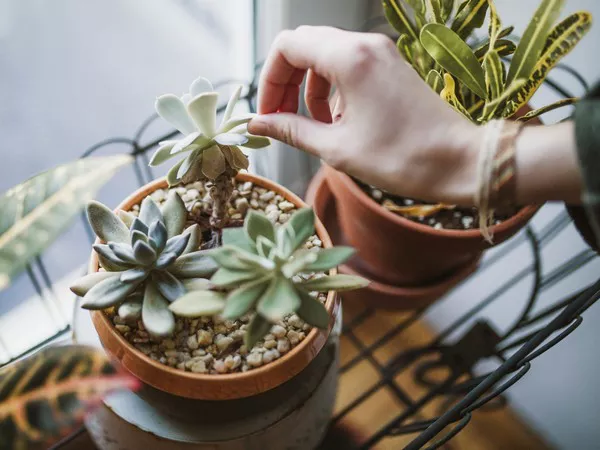Succulents, with their captivating shapes and colors, have become a beloved addition to homes and gardens worldwide. One of the most rewarding aspects of cultivating these plants is propagation – the process of creating new plants from existing ones. Taking cuttings from succulents and successfully rooting them is a skill that allows enthusiasts to expand their collections, share plants with others, and witness the captivating journey of growth. In this guide, we will delve into the art of succulent propagation through cuttings, exploring the techniques, considerations, and best practices to ensure success.
Understanding Succulent Propagation
Propagation is a fundamental practice in gardening, enabling growers to reproduce plants without relying on seeds. Succulents are particularly well-suited to propagation due to their ability to generate new roots and shoots from cuttings. A cutting is a detached portion of a succulent that, when given the right conditions, can develop into a fully-fledged plant. This method of propagation retains the genetic traits of the parent plant, ensuring that desirable features are preserved in the offspring.
1. Selecting the Right Succulent
Choose Healthy Parent Plants: To ensure successful propagation, begin with healthy and disease-free parent plants. Plants that exhibit robust growth, vibrant colors, and no signs of stress are ideal candidates for taking cuttings.
Consider Propagation Timing: The best time to take cuttings is during the active growing season, typically spring or early summer. At this time, succulents are more responsive to rooting and have a higher chance of successful propagation.
2. Gathering the Essential Tools
Clean, Sharp Scissors or Pruners: Cleanliness is crucial to prevent the introduction of pathogens. Use sanitized scissors or pruners to ensure clean cuts that minimize damage to the parent plant.
Drying Tray or Container: After taking cuttings, allow them to air dry for a day or two before planting. A drying tray or container with good airflow is essential to prevent cuttings from rotting.
3. Taking the Cuttings
Select the Cuttings: Choose healthy stems that are free from damage or disease. Look for stems that are long enough to provide ample space for planting, typically around 3 to 6 inches.
Make Clean Cuts: Using sharp, clean scissors or pruners, make a clean cut just below a leaf node. A leaf node is a small bump on the stem where leaves emerge. This is where the new roots will develop.
Remove Lower Leaves: Strip the lower leaves from the stem, leaving a bare section of stem that will be inserted into the soil. Allow the cuttings to air dry for a day or two to form calluses. This step reduces the risk of rotting when planted.
4. Preparing the Cuttings for Rooting
Choosing the Right Soil Mix: Use a well-draining succulent or cactus mix for rooting cuttings. These mixes ensure proper aeration and prevent excessive moisture retention.
Allow Adequate Space: Plant the dried cuttings in the soil mix, ensuring there is enough space between cuttings to prevent overcrowding and encourage airflow.
Rooting Hormone (Optional): Some gardeners choose to use rooting hormone to expedite the development of roots. While optional, it can increase the chances of successful rooting.
5. Rooting the Cuttings
Planting Depth: Insert the cut end of the succulent cutting into the soil mix. The leaf node where the leaves were removed should be beneath the soil surface.
Watering Strategy: Water the cuttings lightly after planting to settle the soil around them. Afterward, it’s essential to avoid overwatering. Mist the soil occasionally to maintain a slightly humid environment.
Provide Indirect Light: Place the planted cuttings in a location with bright, indirect light. Avoid direct sunlight, as it can scorch the young plants. A windowsill with filtered light is often a suitable spot.
6. Caring for Rooted Cuttings
Monitor Root Development: Over the next few weeks, monitor the cuttings for signs of root growth. Gently tug on the cutting; resistance indicates the development of roots.
Gradual Acclimatization: Once roots are established, gradually acclimate the young plants to direct sunlight. Start with a few hours of morning sun and increase the exposure over time.
Transplanting to Larger Containers: As the cuttings grow and the root system develops, transplant them into slightly larger containers with well-draining soil. This provides more room for growth.
Conclusion
Succulent propagation through cuttings is a gratifying skill that allows gardening enthusiasts to connect with the life cycle of these remarkable plants. By understanding the best practices for selecting healthy parent plants, making clean cuts, providing appropriate rooting conditions, and nurturing the rooted cuttings, gardeners can enjoy the journey of watching new succulents take root and flourish. Whether you’re expanding your collection, sharing plants with friends, or simply appreciating the marvel of plant propagation, mastering the art of taking and rooting succulent cuttings is a rewarding endeavor that deepens your connection to the botanical world.


